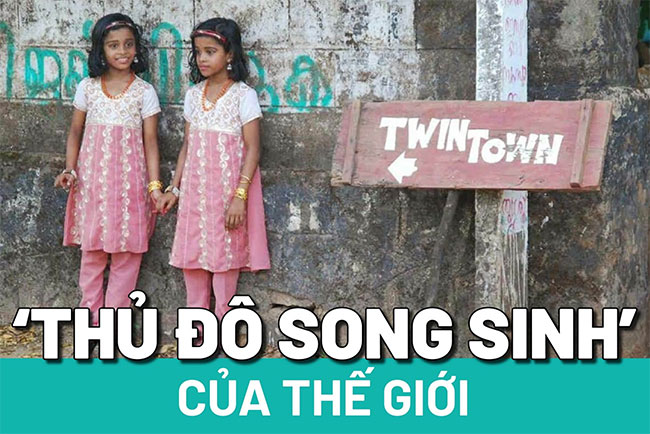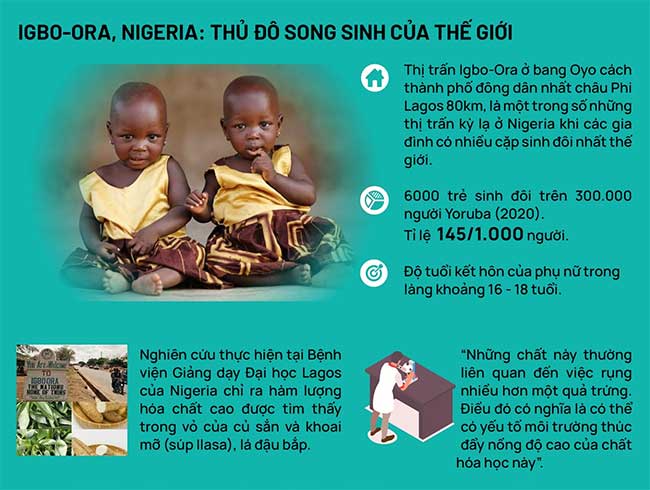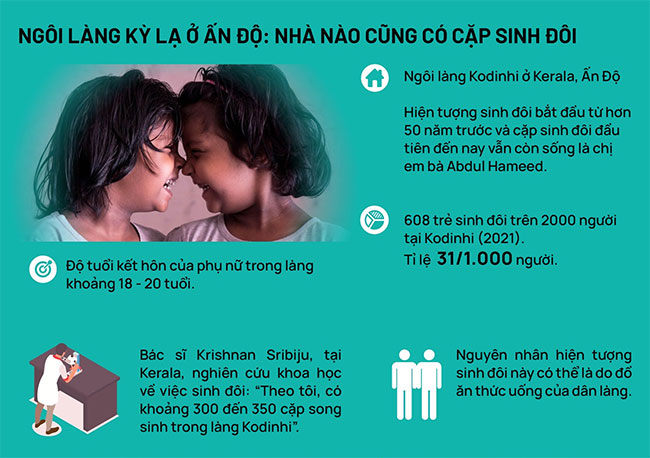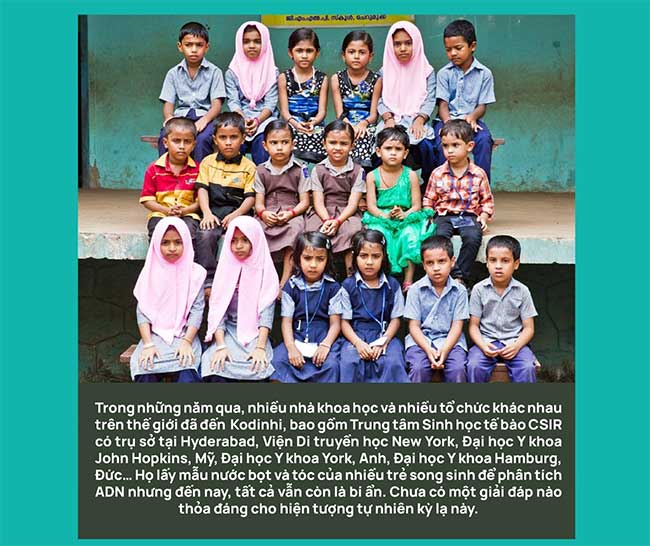The mystery of the world's 'twin capitals'
Igbo-Ora in Nigeria and Kodinhi village in India are strange and mysterious places that produce the most twins in the world at a dizzying rate. Many scientists have tried to explain but the explanations seem unsatisfactory.
Igbo-Ora, located 80km from Africa's most populous city Lagos, is one of the most unusual towns in Nigeria, with the highest rate of twins in the world.





Due to eating too much cassava and Ilasa soup?
The people of Igbo-Ora town are mainly farmers and traders. This town is known as the 'Twin Town of the World' because the rate of twins here is the highest in the world. Almost every house in this town has at least one pair of twins.
While there is speculation that childbearing may be genetic, research suggests that having many children may be linked to the dietary habits of women in this region.
Cassava is quite popular in the Yoruba diet as it can be eaten in many forms such as Amala, Garri, Fufu, etc. There are also many Yoruba stews. A study of twin births conducted at the Lagos University Teaching Hospital in Nigeria showed that high levels of chemicals found in the peels of cassava and yams were found in Yoruba women.
According to a 2001 BBC interview, a consultant gynaecologist who had seen multiple births in hospital said: 'These chemicals are often associated with the release of more than one egg. That means there may be an environmental factor that promotes high levels of these chemicals.'
Many studies have shown that, ' Yoruba women's tuber foods, especially the peels, contain very high amounts of these chemicals. Women from this region have unusually high amounts of these chemicals in their bodies and this encourages the release of more than one egg. There is enough reason to believe in this hypothesis'.
However, the head of the Igbo-Ora community linked the births to the soup they eat with these tubers, saying: 'We eat a lot of okra leaves or Ilasa soup . We also eat a lot of yams and these diets influence the birth of many children.'
Although there is no scientific explanation or evidence to prove that eating cassava or sweet potatoes can cause multiple pregnancies, could the Nigerian Ilesa soup be the reason for the high twin birth rate among Igbo-Ora?
Dr Lawrence, a lecturer in Obstetrics and Gynaecology at the University of York Medical School in the UK, said that it is possible that the yams or okra grown in Igbo-Ora village contain substances that stimulate the female body to produce gonadotropins, a chemical agent that stimulates ovulation. Instead of releasing just one egg, they release two eggs in the same cycle, but Dr Ekujumi Olarenwaju, a lecturer at the University of Lagos Medical School, has a different explanation: ' Over the years of observation, I have seen women in Igbo Ora give birth to twins due to two sperm fertilizing one egg, not necessarily two eggs, so the cause could be genetic mutation'.
According to the research team of Dr. Davis Pollock, John Hopkins University of Medicine, USA: 'In 2 years, we had 10 women volunteer to participate in the experiment right before their wedding day. By ultrasound of the ovaries, we determined that all 10 people only ovulated 1 egg, but when they were 6 weeks pregnant, 3 out of 10 were twins. That explains that there were 2 sperms of the husband fertilizing 1 egg, but why the rate was so high, we cannot answer'.

A woman poses for a photo with her twins ahead of the Igboora World Twins Festival in Igbo-Ora. (Photo: AFP).
Scientists are studying the genetics and attractiveness of twins, which could help them find a partner and increase their chances of having children. Whatever the reasons, the Igbo-Ora people agree that having twins is a blessing - especially as Nigeria faces its worst economic crisis in a generation.
Suliat Mobolaji, 30, gave birth to twins eight months ago. She couldn't hide her joy when she said : 'Having twins has changed my life. You can't have twins without luck. It's a gift from God.'
The festivities over the weekend added to the joy. A red carpet was rolled out for a parade of twins, young and old, all dressed in matching outfits, from traditional adire garments to petite girls in purple dresses and matching handbags. Dozens of other pairs of twins also lined the streets of the town.
The organisers, who are also twins, are hoping to set a world record for the largest number of twins attending one event. Twin brothers Taiwo and Kehinde Oguntoye, 39, are also planning a mass wedding for twins next year.
'Twins bring good luck, fame and fortune. That is why we Yoruba people always welcome the birth of twins, and perhaps why God has blessed us with the highest number of twins in the world,' Taiwo proudly said .
Strange village in India because every house has twins
Doctors in India are racking their brains to solve the riddle of more than 220 sets of twins born to 2,000 families in the remote village of Kodinhi in Kerala. Experts are puzzled by the rare twin birth phenomenon, which is nearly six times higher than the global average.
In 2008, 300 women gave birth to healthy babies and among them, 15 pairs of twins were born in the village. According to the census, 60 pairs of twins were born in the last 5 years in Kodinhi village. Thus, the rate of twin births is increasing every year and is expected to break the previous record by 2017.
Dr Krishnan Sribiju, a doctor in Kerala who has been doing scientific research on twins, has been trying to get to the bottom of the mystery of the high number of twin births in Kodinhi for two years. He believes that the actual number of twins in the village is much higher than the official figures. 'I think there are around 300 to 350 pairs of twins in Kodinhi village,' says Dr Sribiju.
'What is interesting is that the number of twins is increasing every year, to the extent that I feel in the last 10 years the number of twins in Kodinhi has doubled,' he added .
Villagers say the twin births date back three generations. 'To the best of my knowledge, this medical miracle began about 60 to 70 years ago,' Dr Sribiju added.
According to him, the possible cause of this twin phenomenon could be due to the food and drink of the villagers. Dr Sribiju said: 'Without detailed biochemical analysis equipment, I cannot say for sure the reason for the twin births, but I feel it is related to what the villagers eat and drink'.
He added that he has ruled out genetic factors or any unknown contaminants that could be the reason behind the village's localized nature.
'Considering the low rate of twinning in India, especially in Asia, it is surprising to see a village in India with an overwhelming number of twins. The rate of twinning globally, especially in Western countries, has increased due to IVF. Also, twins are usually born to older women. In Kodinhi, this is not the case because the age of marriage here is much younger, around 18–20 years,' said Dr Sribiju.
- The only country in the world that owns up to 3 capitals
- The mystery behind the phenomenon 'other half-sister twins
- Discovering many cosmic mysteries, people yearn to find new worlds
- Kangaroo is a rare twin in Australia
- Discover the 168-year mystery of the largest volcanoes in Hawaii
- Answer the mystery about the ship at the foot of the New York Twin Towers
- The twin twin stars are very different
- The world's tallest twin tower helps clean the air
- The 10 cleanest capitals in the world
- What is twin blood transfusion syndrome?
- The mystery of the twins' relationship
- The United States appears rare twin manatees
 The truth about the mysterious red-haired giant at Lovelock Cave
The truth about the mysterious red-haired giant at Lovelock Cave Inunaki Tunnel: The haunted road leading into Japan's 'village of death'
Inunaki Tunnel: The haunted road leading into Japan's 'village of death' The mystery of the phenomenon of human reflection before dying
The mystery of the phenomenon of human reflection before dying 6 mysterious phenomena, although science has been developed for a long time, still cannot be answered
6 mysterious phenomena, although science has been developed for a long time, still cannot be answered